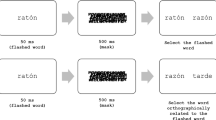Abstract
The present study examined the inhibitory processes of spoken word recognition of Chinese homophones during sentence processing, using a standard cross-modal naming experiment with an innovative design and materials construction. Results confirmed that (1) preceding sentence context has exerted an early effect on disambiguating among different alternative meanings of the homophones; (2) the contextually inappropriate meanings of the ambiguous word were inhibited rapidly during sentence processing; and (3) the present results also demonstrated that the inhibitory mechanism could be sustained to a longer duration following the occurrence of the ambiguous word (homophone). Finally, all these results clearly revealed the dynamics of interaction of context effects and spoken word recognition processes.
Similar content being viewed by others
References
Ahrens, K. (2002). Timing issues in lexical ambiguity resolution. In M. Nakayama (Ed.), Sentence processing in East Asian languages (pp. 1–29). Stanford, CA: CSLI Publications.
Ahrens, K. (2006). The effect of visual target presentation times on lexical ambiguity resolution. Language and Linguistics, 7, 677–696.
Chen, Y.-M., & Cui, Y. (1997). The processing of Chinese ambiguous sentences. Acta Psychologica Sinica, 29, 1–7.
Cohen, J. D., MacWhinney, B., Flatt, M., & Provost, J. (1993). PsyScope: A new graphic interactive environment for designing psychology experiments. Behavior Research Methods, Instruments, and Computers, 25, 257–271.
Fodor, J. A. (1983). The modularity of mind: An essay on faculty psychology. Cambridge, MA: MIT Press.
Gernsbacher, M. A., & Faust, M. (1991). The role of suppression in sentence comprehension. In G. B. Simpson (Ed.), Understanding word and sentence (pp. 97–128). Amsterdam: Elsevier Science Publishers.
Glucksberg, S., Kreuz, R. J., & Rho, S. H. (1986). Context can constrain lexical access: Implications for models of language comprehension. Journal of Experimental Psychology: Learning, Memory, and Cognition, 12, 323–335.
Gorfein, D. S. (Ed.). (1989). Resolving semantic ambiguity. New York: Springer.
Grosjean, F. (1980). Spoken word recognition processes and the gating paradigm. Perception and Psychophysics, 28, 267–283.
Ho, H.-H., & Jiang, Y.-H. (1994). Word frequency in Hong Kong in the 90’s. Research Institute of Humanities, Chinese University of Hong Kong.
Hogaboam, T., & Perfetti, C. (1975). Lexical ambiguity and sentence comprehension. Journal of Verbal Learning & Verbal Behavior, 14, 265–274.
Institute of Linguistics, The Academy of Social Sciences. (1985). Xianda Hanyu Cidian (Modern Chinese Dictionary). Beijing: Commercial Press.
Li, P., & Yip, M. C. W. (1996). Lexical ambiguity and context effects in spoken word recognition: Evidence from Chinese. In G. Cottrell (ed.) Proceedings of the 18th annual meeting of the cognitive science society, pp. 228–232.
Li, P., & Yip, M. C. W. (1998). Context effects and the processing of spoken homophones. Reading and Writing, 10, 223–243.
Li, P., Shu, H., Yip, M. C. W., Zhang, Y., & Tang, Y. (2002). Lexical ambiguity in sentence processing: Evidence from Chinese. In M. Nakayama (Ed.), Sentence processing in East Asian languages (pp. 111–129). Stanford, CA: CSLI Publications.
Locker, J. L., Simpson, G. B., & Yates, M. (2003). Semantic neighborhood effects on the recognition of ambiguous words. Memory & Cognition, 31, 505–515.
Marslen-Wilson, W. D. (1987). Functional parallelism in spoken word recognition. Cognition, 25, 71–102.
Marslen-Wilson, W. D. (1990). Activation, competition, and frequency in lexical access. In G. T. Altmann (Ed.), Cognitive models of speech processing (pp. 148–172). Cambridge: The MIT Press.
Marslen-Wilson, W. D., & Welsh, A. (1978). Processing interactions and lexical access during word recognition in continuous speech. Cognitive Psychology, 10, 29–63.
McClelland, J. L. (1987). The case for interactionism in language processing. In M. Coltheart (Ed.), Attention and performance XII: The psychology of reading (pp. 3–36). Hillsdale, NJ: Erlbaum.
McClelland, J. L., & Elman, J. (1986). Interactive processes in speech perception: The TRACE model. In J. L. McClelland, D. E. Rumelhart, and the PDP Research Group (Eds.), Parallel distributed processing: Explorations in the microstructure of cognition (vol. II) (pp. 58–121). Cambridge: The MIT Press.
McQueen, J. M., & Sereno, J. (2005). Cleaving automatic from strategic effects in phonological priming. Memory & Cognition, 33, 1185–1209.
Morris, R. K., & Binder, K. S. (2001). What happens to the unselected meaning of an ambiguous word in skilled reading? In D. Gorfein (Ed.), On the consequences of meaning selection: Perspectives on resolving lexical ambiguity (pp. 139–153). Washington, DC: American Psychological Association.
Neely, J. H. (1991). Semantic priming effects in visual word recognition: A selective review of current findings and theories. In D. Besner & G. Humphreys (Eds.), Basic processes in reading: Visual word recognition (pp. 264–336). Hillsdale, NJ: Erlbaum.
Onifer, W., & Swinney, D. A. (1981). Accessing lexical ambiguities during sentence comprehension: Effects of frequency of meaning and contextual bias. Memory & Cognition, 9, 225–236.
Simpson, G. B. (1981). Meaning dominance and semantic context in the processing of lexical ambiguity. Journal of Verbal Learning and Verbal Behavior, 20, 120–136.
Simpson, G. B. (1984). Lexical ambiguity and its role in models of word recognition. Psychological Bulletin, 96, 316–340.
Simpson, G. B., & Kang, H. (1994). Inhibitory processes in the recognition of homograph meanings. In D. Dagenbach & T. H. Carr (Eds.), Inhibitory processes in attention, memory, and language (pp. 359–381). London: Academic Press.
Simpson, G. B., & Krueger, M. A. (1991). Selective access of homograph meanings in sentence context. Journal of Memory and Language, 30, 627–643.
Swinney, D. A. (1979). Lexical access during sentence comprehension: (Re)Consideration of context effects. Journal of Verbal Learning and Verbal Behavior, 18, 645–659.
Tabossi, P. (1988a). Accessing lexical ambiguity in different types of sentential contexts. Journal of Memory and Language, 27, 324–340.
Tabossi, P. (1988b). Effects of context on the immediate interpretation of unambiguous words. Journal of Experimental Psychology: Learning, Memory, and Cognition, 14, 153–162.
Twilley, L., & Dixon, P. (2000). Meaning resolution processes for words: A parallel independent model. Psychonomic Bulletin & Review, 7, 49–82.
Wu, N., & Shu, H. (2001). Meaning activation of Chinese syntactic category ambiguous words in Isolation. Acta Psychologica Sinica (in Chinese), 33, 305–311.
Yates, M., Locker, L., & Simpson, G. B. (2003). Semantic and phonological influences on the processing of words and pseudohomophones. Memory & Cognition, 31, 856–866.
Yip, M. C. W. (2000). Spoken word recognition of Chinese homophones: The role of context and tone neighbors. Psychologia, 43, 135–143.
Yip, M. C. W. (2002). Access to homophonic meanings during spoken language comprehension: Effects of context and neighborhood density. In Proceedings of ICSLP’2002, pp. 1665–1668.
Yip, M. C. W. (2007). Spoken word recognition of Chinese homophones: A further investigation. In Proceedings of interspeech’2007, pp. 362–365.
Yip, M. C. W. (2008a). Lexical and sentential priming of ambiguous words. Psychologia, 51, 196–205.
Yip, M. C. W. (2008b). Inhibitory processes of Chinese spoken word recognition. In Proceedings of interspeech’2008, pp. 2873–2876.
Yip, M. C. W. (2009). Context effects and the processing of ambiguous words: Further evidence from semantic incongruence. In Proceedings of interspeech’2009, pp. 1871–1874.
Zhang, L.-Y., & Zhang, S.-Y. (1987). Guoyin Yueyin Suoyin Zihui (A Pronunciation Dictionary of Cantonese and Putonghua). Hong Kong: Chung Hwa Bookstore.
Zhang, Y, Shu, H., Li, P., & Liu, Y. (2001). Inhibitory processes, homophone meanings recognition, and spoken discourse comprehension in Chinese. In Proceedings of the third international conference on cognitive science, pp. 221–226.
Zhang, Y., Wu, N., & Yip, M. C. W. (2006). Lexical ambiguity resolution in Chinese sentence processing. In P. Li, L. H. Tan, E. Bates, & O. J. L. Tzeng. (eds.) Handbook of East Asian psycholinguistics (vol. 1: Chinese), pp. 268–278. Cambridge, UK: Cambridge University Press.
Author information
Authors and Affiliations
Corresponding author
Additional information
This research was partially supported by funding from the Research Grants Council of the Hong Kong University Grants Committee [GRF No.: 845613]. I would like to thank Katherine Leung and Carol Chan for their assistance in materials preparation to the present study and the constructive comments from the anonymous reviewers.
Appendix
Rights and permissions
About this article
Cite this article
Yip, M.C.W. Meaning Inhibition and Sentence Processing in Chinese. J Psycholinguist Res 44, 611–621 (2015). https://doi.org/10.1007/s10936-014-9308-4
Published:
Issue Date:
DOI: https://doi.org/10.1007/s10936-014-9308-4




